The Drifter review
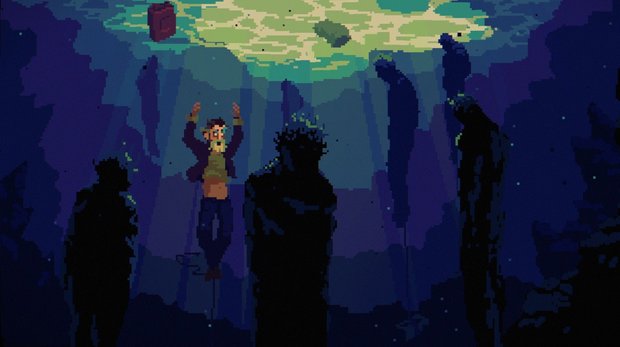
- 3 Comments
Impossible to resist being swept up and carried away by this mature, gorgeously designed retro-styled thriller
When I play through a traditional adventure game, rarely do I anticipate getting to describe it as “action-packed.” But in considering my experience playing through The Drifter, I keep coming back to phrases like “breakneck speed” and “pulse-pounding” that I rarely expect to use in my pointing and clicking. Aside from some minor faults in its die-and-revive puzzle sections, Powerhoof’s stunning retro-styled thriller is an incredible achievement that balances an emotionally mature story with wickedly clever minute-to-minute conundrums that stuck with me long after the dust had settled.
You play as Mick Carter, an average middle-aged guy who has been homeless and wandering place to place for years. At the turn of the 21st century, he receives a phone call from his sister Annie that their mom has died and he should come back for the funeral. After hitching a ride on a train car to his hometown, Mick’s reunion is cut short when he witnesses a brutal murder by mysterious figures clad in black, sporting strange visors with three distinct glowing eyes. He’s captured and knocked unconscious, and when Mick comes to he finds himself tied up and underwater with barely enough air to come to terms with his nightmare situation. You are given the freedom to act in an attempt to free him, unfortunately to no avail.
Mick ultimately drowns – but surprisingly, that doesn’t end his story. After dying, there’s a strange white light that engulfs him completely. Then, miraculously, Mick comes back to life, shortly before the moment when he died. This time, using the knowledge gathered in the previous attempt at cutting him loose, you’re able to help him escape, narrowly avoiding death, gasping for air after emerging from his nearly watery grave. Now it’s up to you to get to the bottom of Mick’s newfound apparent immortality while spiraling into a deep conspiracy of underground corporations, family ties, and unfolding madness.
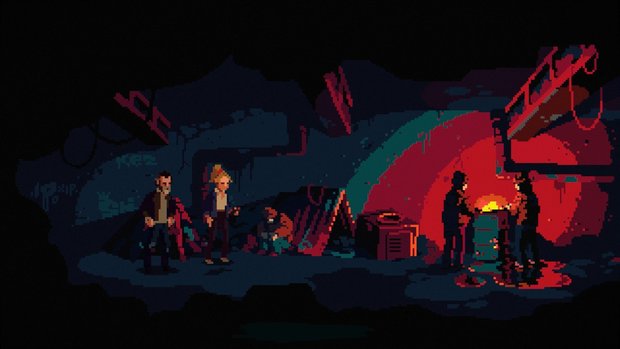
To say The Drifter starts with a bang is an understatement. This is an eight-hour adventure that moves at a swift pace and doesn’t pull punches. You control Mick either through typical point-and-click mechanics, keyboard controls, or through a dual analogue stick control scheme provided for gamepad support. Everything is handled through a simple one-click interface: moving the cursor over hotspots in the environment will show a line of descriptive text written out detailing Mick’s thoughts, and whenever something is interactive, the cursor will change accordingly.
Hidden at the top of the screen is your inventory of collected items and any mental notes of dialogue options unlocked through conversations/revelations you experience throughout the story. These dialogue options can then be used in conversation with other characters, and as you learn more about each topic (i.e. telling people you were abducted and drowned) you’ll be able to select them again. If any options aren’t available in conversation with a particular character, that choice will be grayed out to indicate they have nothing to say about that line of inquiry. It’s a clever system that feels like you’re naturally learning more about the situation, and you can check out Mick’s thoughts by hovering over each note you’ve collected in the top menu to view a short text descriptor.
While this may sound like a lot of variables, thankfully only relevant points of interest are kept tracked in the dialogue tree. That way you don’t have to keep scrolling past the option for asking where the cemetery is after you’ve already met up with Mick’s sister there, for example. The same is true for the items in your inventory. Rarely do you have access to more than five items at a time, and whenever something is no longer needed, it’s removed from your inventory automatically. This greatly minimizes the risk of getting stuck trying to figure out what objects you actually need to progress and which have outlived their usefulness.
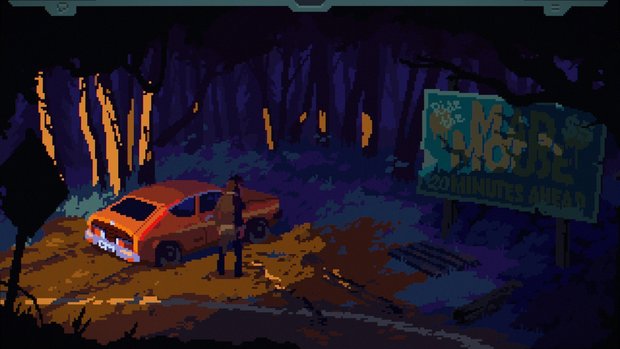
Most scenarios provide just enough environmental context to understand where you need to go next. If you find a note that includes a phone number on the back, naturally you’ll want to find somewhere to use a phone to see who picks up. You’re refused entry at the cemetery by the groundskeeper upon arrival, which means you won’t just be able to waltz in to attend the funeral of Mick’s mom. The details suggest what steps you should be taking to keep moving forward, but without ever feeling it’s so obvious that you’re being told explicitly what to do.
Puzzles are similarly intuitive. Very rarely did I find myself using an inventory item with everything else to guess what the game required, and when I found the answer in these cases, it was more a matter of having to think through the puzzle a bit more than the game thwarting me with impossible moon logic. With that being said, it’s unfortunate that there is no dedicated hint system available in The Drifter. While the puzzles are generally at the sweet spot of just hard enough to pose a decent challenge, I can see some adventurers potentially hitting a wall with certain sections that could have been avoided with a small nudge in the right direction. While this is not much of a problem when there is ample time to try out item combinations, it’s exacerbated by the sequences in which Mick can meet an untimely (almost) demise.
As with his drowning incident, Mick is able to die other ways and keep coming back. That doesn’t mean he’s invincible – if you get shot, you’re going to be sent back to before you tried to avoid the gunshot. But it does mean that you get an infinite number of chances to figure out how to use the environment to your advantage to overcome any deadly challenge thrown Mick’s way. The problem is that there’s no good way to figure them out other than copious amounts of trial and error. And because there’s a limited amount of time in most of these scenarios before Mick gets killed, you’re on a short clock to test out whatever you can before you get reset to the start of the encounter.
Thematically this makes sense, given the many dangers Mick faces and his newfound ability to return from death. Ironically, however, these dying puzzles feel much slower paced than the others, since you may have to exhaust all options available in order to learn how to deal with each new hazard. There aren’t many puzzles where you have to specifically go through this die/revive process, and there’s never a need for fast reflexes instead of quick thinking, but it’s a shame there isn’t more of a logic-based approach you can use up front for a perfect first go at a challenge.
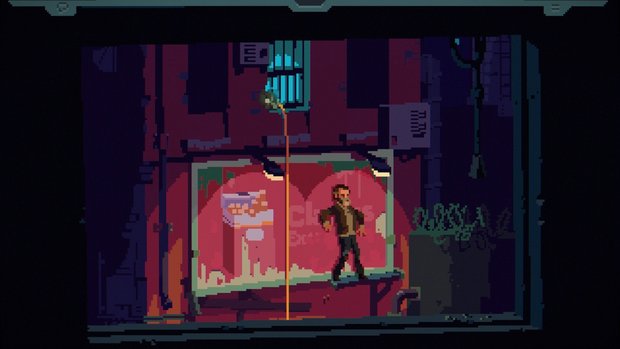
Even when not being thrown into life or (near) death experiences, Mick’s adventure is far from leisurely. You might technically have all the time in the world, but the constant sense of narrative urgency will keep the pressure on, compelling you to continually push forward. One puzzle has you putting together a makeshift Molotov cocktail while ducking behind cover, another requires you to break into a building to scan for information relating to the town cemetery. The amount of gore in this game is also cranked up to 11, reminding you that brutal danger is never far away. In just the first few minutes of the game, you see a man get viciously gunned down, bathing a train car in a fountain of red pixels, but it never tips over into the realm of absurdity with the amount of violence on display.
It might seem surprising to say of a game this bloody, but holy dang, The Drifter is absolutely breathtaking. The pixel art is gorgeous, and screenshots don’t do its beauty justice. Every location is packed with little details that bring them to life: Annie’s apartment is littered with toys strewn about, left there by bored children; and eerie streetlights dimly illuminate a dank underpass populated by homeless folks. Each hub area you go to comes with its own map to travel between locations – the first of which being Mick’s hometown – where you can choose to travel between any of the places you’ve already visited with the push of a button. (Each section has a traversal method befitting the location you’re exploring.) The design is highly reminiscent of the French Quarter map used in Gabriel Knight: Sins of the Fathers, along with Mick’s to-scale fingers holding the map on either side.
Better than the artwork itself is seeing everything in motion. From the first time the train screeches around a corner after starting from the title screen, it’s clear this game is on a different level of pixel perfection. A spotlight shining through what was once a pitch-black tunnel causes Mick to shield his eyes and step back, while opposite him a mysterious man in a yellow jacket whips out a gun, threatening to shoot. Another tense moment has Mick jumping out a window while holding onto a dangling cord for dear life, desperately scrambling to hang on. One particular scene cast against a desert sunset made my jaw drop: clouds of pink and orange hues floated around as far back as the field of view extended. Characters are all equally top-notch in their fluid animations. Even with limited facial features, a huge array of emotions are expressed through people’s eyes growing wide or leaning forward to accentuate their anger while yelling out. Several scenes are zoomed in to express even more layers of detail, such as when Mick gets tied up and drowned early on.
Character animation in The Drifter is matched only by the stellar quality of the vocal performances bringing them to life. Mick’s ex-wife Sarah seems unsure what to make of his sudden reappearance, and her portrayal serves to anchor Mick to reality while everything around him gets increasingly more sci-fi. A suspicious man in a bucket hat has an eerily childish whimsy in his voice that makes even the first encounter with him feel a bit… off. As good as the supporting cast is, however, one performance towers above the rest: Adrian Vaughan gives an all-time best portrayal as Mick Carter, with sarcastic quips and down-to-earth delivery becoming a genuine sense of utter desperation when the situation requires it. Mick doesn’t just talk when you’re conversing with other characters, either. Most of the game is fully narrated by him as well. Every action, every death, every revelation – all of it comes accompanied with Mick’s deep Australian drawl. In less adept hands, this could have proved a disastrous tone destroyer – but Adrian’s phenomenal performance gets you inside Mick’s head and succeeds in leading you further along this insane roller coaster ride of emotion.
Believable voice acting is so important, because this is an incredibly mature storyline about loss and the inevitability of all things, and every performer delivers on selling every line of dialogue. Scenes of horrific torture, reveals of family members long dead, being confronted by those you love after leaving everything behind… Many major events occur over the course of the game, to the point that listing any more here would spoil the fun of uncovering it for yourself. The surprises never let up, and it all pays off with a powerful finale that brings together every loose thread with a satisfying conclusion.
Wrapping all this up in a sleek ribbon is The Drifter’s amazing high-octane electronic soundtrack that perfectly accompanies the quick-moving action. From the moment the game boots up, you’re greeted by the powerful blaring of synthesizer tones reminiscent of a neon-soaked 80s action flick. The music is incredibly versatile, though, ranging from over-the-top intensity to unsettling surreal nightmare fuel when the story demands it. The score working in tandem with the killer sound design makes every explosion, gunshot, and dramatic reveal hit that much harder.
Final Verdict
The Drifter is an enigma in the best of ways. It’s a classic point-and-click adventure with mostly leisurely gameplay, but with the tone and speed of a guns-blazing action thriller. Mick is a believable and flawed lead in this tale, and it makes him an incredible character to play – especially with Adrian Vaughan bringing him so superbly to life. While I would have liked to see a hint system for some of the trickier puzzle scenarios, along with clearer solutions to the murderous timed scenarios that aren’t so leisurely, these are such small gripes when compared with everything The Drifter excels at. With stunning production values, entertaining gameplay, and a brilliantly performed thought-provoking story, this is pulp sci-fi at its best.
Hot take
Belying its leisurely point-and-click gameplay, The Drifter is an incredible action-packed thrill ride with a riveting storyline that unfolds hard and fast.
Pros
- Stunning pixel art and animation
- Phenomenal mature story pulls no punches
- Incredible pulse-pounding soundtrack
- Clever fast-paced puzzle design keeps the action moving
Cons
- Lack of hint system might lead to frustration in a few places
- Reliance on trial-and-error structure in death/rebirth puzzles
Sam played The Drifter on PC using a review code provided by the game's publisher.


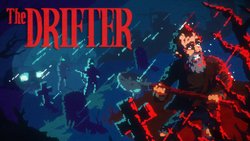





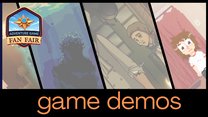
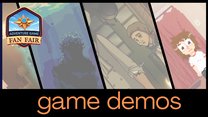

3 Comments
Want to join the discussion? Leave a comment as guest, sign in or register in our forums.
Sounds even better than expected! Bought and installed, now to find the time to play 😉
Reply
Good review. I've never heard of this game, and it turned out to be amazing.
Reply
I loved the 'Australian-ness' of it all. We are all so used to point-and-click adventures being set in the US as default, with the occasional period piece (e.g., in the Victorian era) set in England, but it was a rare treat to play a game so unashamedly Aussie.
Reply
Leave a comment